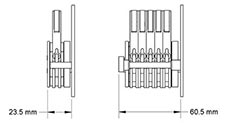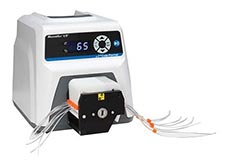Begrundanden avseende flerkanalig peristaltisk pump för tillverkare av originalutrustning OEM
Considerations When Using Multichannel Peristaltic Pumps for OEM Applications
by John Batts – Senior Technical Specialist, Masterflex
In many industries, peristaltic pump technology has proven to be invaluable. With its ability to pull (or lift) fluids from a long distance, self prime, pump fluids with suspended solids, and wide range of use from cell sorting at microliter flow rates to wastewater treatment at gallons per minute, peristaltic pumps are a popular pump choice over other options for many reasons.
Peristaltic pump technology offers an unrivaled capacity in the world of pumps with multichannel, continuous flow platforms. With multichannel peristaltic pumps, you can realize several advantages:
- Support for multiple channels on a single drive mechanism
- Ability to pump multiple fluid streams simultaneously without risk of carryover or cross-contamination
- Flexibility for both dispensing and continuous flow with solid reproducibility and consistent performance across all channels
These advantages make multichannel peristaltic pumping an enabling technology for many OEM customers. In applications such as drug discovery, drug and reagent testing, batch processing, fertilizer and pesticide dispensing, and veterinary research, there are countless ways multichannel peristaltic pumps have opened the doors of possibility. To best determine if multichannel peristaltic pumps are the right fit for your application, consider the following:
Per-Channel Flow Rate
Because of the way tubing is secured on a multichannel peristaltic pump, coupled with an OEM company’s need for a compact design, both the tubing and the motors used to drive these pumps tend to be smaller than comparable single-channel pumps. This makes multichannel peristaltic pumps ideal for lower flow applications where flow rates and dispensed volumes are measured in microliters and milliliters.
Additionally, most multichannel peristaltic pumps have the channels connected to a single motor or rotor shaft assembly. This allow these pumps to remain compact and be easily integrated into other system hardware. This feature also ensures all the channels rotate simultaneously at the same speed and in the same direction, which helps generate consistent performance across all channels.

However, the design of most multichannel peristaltic pumps requires all channels to operate in an identical fashion. Thus, for applications, where precise control of the flow rate or dispensed volume on a per-channel basis is important, either an array of single-channel pumps must be used or our Ismatec® Reglo ICC multichannel pumps can be considered. Unlike typical multichannel peristaltic pumps, these pumps feature a proprietary technology that allows each channel to be controlled independently. Available in stand-alone or panel-mount options, these pumps are ideal for smaller-flow applications where variable and independent control of each channel is important.
Another design consideration when choosing the best pump option to use is the overall footprint of the pump. With bench space at a premium, many customers are demanding smaller and smaller packages for the systems they purchase. That means the pump technology chosen to be incorporated into those systems must also be able to support that design goal. Multichannel peristaltic pumps certainly offer a compact design for the number of channels supported. The typical arrangement of virtually all multichannel peristaltic pumps requires the various channels to be positioned inline with each other. Thus, when a multichannel peristaltic pump is chosen to be part of a system, sufficient space must be made available to accommodate its overall length. Figure 2 below compares the depth differences of a single-channel peristaltic pump versus a multichannel peristaltic pump.

Cassettes (Cartridges) and Stopped Tubing
One nuance about working with multichannel peristaltic pumps is centered around the tubing used for the fluid pathway and how that tubing is connected to the pump head.

For most multichannel peristaltic pumps, to save on space, it is common for each channel to use some type of cassette to secure the tubing in place on the pump head.
These cassettes help hold the fluid pathway tubing in place against the rollers and their compact design helps minimize the overall length of the pump head. Cassettes can be very convenient, as they typically feature consistent performance and are easily replaced. Additionally, cassettes typically use stopped tubing for a portion of the fluidic pathway.
Stopped tubing attached to the cassettes has that name because stops, or collars, are present on the outer wall of the tubing, shown in Figure 3.
These stops have two purposes:
The first and primary purpose is to retain the tubing in place in the cassette. The stops prevent the tubing from moving with the rollers as they rotate. The stops also ensure consistent tension on the tubing for more consistent fluid delivery between each channel and as tubes are changed periodically.
A secondary purpose for the stops is to identify the inner diameter (ID) of the tubing. Many of the IDs are small and close in size to other options, making it challenging to visibly tell the difference between them. To distinguish between the various sizes available and make ordering replacement tubing easier, tubing manufacturers use an industry standard color-coding system for the stops on the tubing. These color combinations allow the tubing ID to be easily identified. For example, orange-black represents an ID of .013 mm and orange-red represents an ID of .19 mm.
Most stopped tubing assemblies are available in convenient packs of pre-cut lengths. As such, consistent performance from tube to tube is assured. Additionally, because stopped tubing is manufactured in pre-defined lengths, most users of this tubing will also incorporate extension tubing into the overall fluidic pathway. This helps make routine maintenance less intrusive and less disruptive to the fluidic pathway, as the stopped tubing is typically the only portion of the fluidic pathway that needs to be changed regularly.
Of course, both the stops and the overall length of the tubing can be customized for specific OEM requirements. For best implementation of stopped tubing and multichannel peristaltic pumps into a system, consult with a Masterflex Custom Solutions representative to help compare the advantages of working with off-the-shelf stopped tubing assemblies with the advantages of incorporating a custom stopped tubing assembly into a system.
Overall, multichannel peristaltic pumps enhance the value and expand the usefulness of peristaltic pumping technology in many different applications. And keeping the topics mentioned above are kept in mind, it can help ensure the successful integration of multichannel peristaltic pumps into your system.